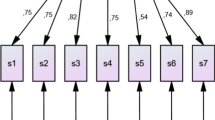Abstract
Within contemporary psychology there is increasing interest in the role of religion on behaviour and psychological functioning. Such interest can be attested to by the growth in the number of pertinent books and articles that have been published and also the development of new self-report measures of religiosity. The Santa Clara Strength of Religious Faith Questionnaire is one such recently developed measure. It is a brief self-report measure comprising 10 items that were designed to measure strength of religious faith regardless of religious denomination or affiliation. Although Plante and Boccaccini (1997a, 1997b) have provided some preliminary evidence for the reliability and validity of the scale, the factor structure of the scale has not yet been examined. The aim of the present paper was to confirm the factor structure of the scale. The hypothesised one-factor model was tested using confirmatory factor analytic methods. Data from a sample of 106 Northern Irish undergraduate university students were examined using confirmatory factor analytic methods. A one-factor model was tested and accepted on the basis of fit statistics, therefore supporting the hypothesised unidimensional structure of the scale. The present results provide further evidence that the Santa Clara Strength of Religious Faith Questionnaire is psychometrically sound and therefore it can be recommended for further use by researchers interested in the construct of strength of religious faith.
Similar content being viewed by others

REFERENCES
Batson, C. D., & Ventis, W. L. (1982). The religious experience: A social-psychological perspective. New York: Oxford University Press.
Bendig, A. W. (1954). Age, sex, and the Manifest Anxiety Scale test. Journal of Consulting Psychology, 18, 16.
Berrenberg, J. L. (1987). The Belief in Personal Control Scale: A measure of God-mediated and exaggerated control. Journal of Personality Assessment, 51, 194–206.
Bhugra, D. (1996). Psychiatry and religion: Context, consensus and controversies. London: Routledge.
Cronbach, L. J. (1951). Coefficient alpha and the internal structure of tests. Psychometrika, 16, 297–334.
Crowne, D. P., & Marlowe, D. (1960). A new scale of social desirability independent of psychopathology. Journal of Consulting Psychology, 24, 349–354.
Cutrona, C. D., & Russell, D. W. (1987). The provisions of social relationships and adaptation to stress. In W. H. Jones & D. Perlman (Eds.), Advances in personal relationships, Vol 1. Greenwich, CT: JAI Press, pp. 37–67.
Derogatis, L. R. (1977). SCL-90–R Manual-I. Baltimore: Clinical Psychometric Research.
Fabo, T., & Belk, S. S. (1985). A short scale to measure self-righteousness. Journal of Personality Assessment, 49, 72–77.
Gorsuch, R. I., & Venable, G. D. (1983). Development of an 'age-universal' I-E revised scale. Journal for the Scientific Study of Religion, 22, 181–187.
Greenberg, D., & Witztum, E. (1994). Special section on psychiatry and religion. Israel Journal of Psychiatry and Related Sciences, 31, 143–242.
Hill, P. C., & Hood, R. W. Jr. (1999). Measures of religiosity. Birmingham, Al.: Religious Education Press.
Hoge, D. R. (1972). A validated intrinsic religious motivation scale. Journal for the Scientific Study for Religion, 11, 369–376.
Jackson, M., & Fulford, K. W. M. (1997). Spiritual experience and psychopathology. Philosophy, Psychology and Psychiatry, 4, 41–65.
Jöreskog, K., & Sörbom, D. (1999a). PRELIS 2.30. Chicago: Scientific Software Inc.
Jöreskog, K., & Sörbom, D. (1999b). LISREL 8.30. Chicago: Scientific Software Inc.
Koenig, H. G. (1998). Handbook of religion and mental health. London: Academic Press.
Koenig, H., Pakerson, G. R., & Meador, K. G. (1997). Religious index for psychiatric research. American Journal of Psychiatry, 154, 885–886.
Loewenthal, K. M. (1995). Mental health and religion. London: Chapman and Hall.
Plante, T. G., & Boccaccini, M. T. (1997a). The Santa Clara Strength of Religious Faith Questionnaire. Pastoral Psychology, 45, 375–387.
Plante, T. G., & Boccaccini, M. T. (1997b). Reliability and validity of the Santa Clara Strength of Religious Faith Questionnaire. Pastoral Psychology, 45, 429–437.
Plante, T. G., Yancey, S., Sherman, A., Guertin, M., & Partdini, D. (1999). Further validation for the Santa Clara Strength of Religious Faith Questionnaire. Pastoral Psychology, 48, 11–21.
Schumaker, J. F. (1992). Religion and mental health.New York: Oxford University Press.
Shafranske, E. P. (1996). Religion and the clinical practice of psychology. Washington: American Psychological Association.
Steiger, J. H. (1990). Structural model evaluation and modification: An interval estimation approach. Multivariate Behavioural Research, 25, 173–180.
Synder, C. R. (1995). Conceptualizing, measuring, and nurturing hope. Journal of Counseling and Development, 73, 355–360.
Weinberger, D. A. (1991). Social-emotional adjustment in older children and adults: I. Psychometric properties of the Weinberger Adjustment Inventory. Unpublished Manuscript, Case Western Reserve University, Cleveland, OH.
Author information
Authors and Affiliations
Rights and permissions
About this article
Cite this article
Lewis, C.A., Shevlin, M., McGuckin, C. et al. The Santa Clara Strength of Religious Faith Questionnaire: Confirmatory Factor Analysis. Pastoral Psychology 49, 379–384 (2001). https://doi.org/10.1023/A:1010370728546
Issue Date:
DOI: https://doi.org/10.1023/A:1010370728546


